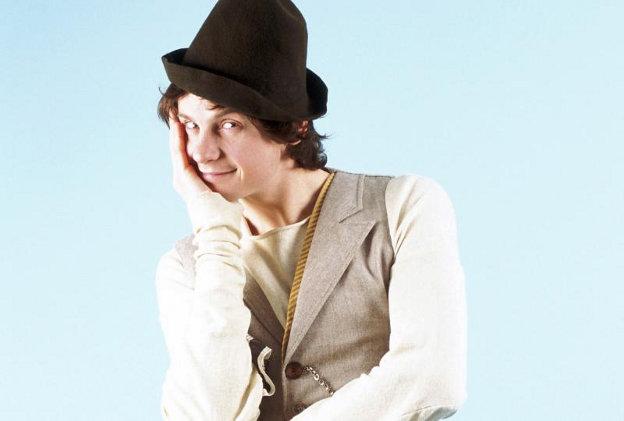An empty stage, curtained back wall, red lights. Enter dishevelled young man in too-short trousers and a floppy felt hat, wielding an invisible broom. Cue classic clown/mime sequence, in which a series of imaginary objects and actions are animated by live sound – the performer’s own squeaks, whistles and body-percussion. Ideas and images start simply and build beautifully. Example: there’s a piece of chewing gum on the floor, it sticks to his shoe; he pulls it off and pops it in his mouth, he chews and chews then pulls out a great long length, which becomes a skipping rope, which becomes a lasso to catch a buzzing fly. Later, there’s a rubber ball that morphs into a beach ball bounced back and forth with the audience, which becomes a football passed to a young boy, who is invited onstage for a game of footy-keepy-uppy, which the boy wins – so the ball gets passed out again to the audience, which then gets lost under the seats.
At which point there is a glorious moment of impromptu audience interaction. A little girl, no more than three years old, scampers down the aisle to help find the ball, hopping happily from one foot to the other. At which point our entertainer stops in his tracks and stands watching her – not for seconds, but for minutes. She hums to herself, oblivious, and carries on peering under seats or picking dust off the floor. It’s a moment worthy of Philippe Gaulier, the on-stage pause in action pushed and pushed, a collective holding of breath giving way to riotous laughter.
And Julien Cottereau is indeed Gaulier trained, his stint with the master-clown coming after his graduation from France’s renowned ENSATT theatre school, and before his long-standing employment with Cirque du Soleil, most famously as the solo mime Eddy in their best show, Saltimbanco. His skills as a clown and mime are superb, and this first section of the show is a perfectly realised showcase of these skills. Here, as elsewhere in the show, these physical skills, together with that clever live sound accompaniment and well-chosen bursts of recorded music (cheery synth bleeps from the Popcorn instrumental Euro-pop hit; moody twangs of Ry Cooder guitar), combine with a simple but strong scenography of light which uses colour washes and spots and strobes to animate the empty stage for each carefully crafted vignette.
The second block of scenes takes us into slightly more grown-up territory, with a dating scenario acted out with a young woman chosen from the audience – the predictable nervous-clown-seeking-a-kiss spoof following on from a slightly suspect model-girl photo-shoot sequence. We then have an interesting section playing out a moral dilemma, in which a wounded dog needs to be put out of its misery, an audience member chosen to fulfil this gruesome task. It’s wonderful how much empathy an audience can be made to feel for an invisible dog! The final big audience participation number brings the ‘girlfriend’ back onstage as a silent-movie melodrama heroine, tied up in sacrifice to an invisible growling beast which has been making an intermittent appearance, through sound and pulsing red light, throughout the show. A large-bodied man picked from the audience is schooled by Cottereau to stomp and growl and slash, but he seems unsure of whether he is supposed to be the beast or the hero, and we are thus also unsure. In all three of these scenarios using adult audience participants, I have the slightly uncomfortable feeling that Cottereau has picked the wrong person to play with.
That could be just bad luck, but I have seen this show before (at the Edinburgh Fringe 2010), and had the same concern about the ‘beast’ section, which similarly fell a little flat. I can’t help thinking that whilst the interactions with children are pure brilliance, and the general whole-audience exchanges are beautifully managed, the grown-ups brought into the action aren’t really dealt with as well as they could be. And at 90 minutes, it all seems to drop a little in energy towards the end. It feels like an hour-long show drawn out beyond its own comfort-zone.
It is hard not to draw comparison to that other famous Gaulier trained solo clown-mime, the Total Theatre Award winner Dr Brown, who seems always to pick the right people – people who morph from audience participants to full-on collaborators in seconds. It also has to be said that in the 21st century, Cottereau’s traditional typecasting of male and female characters seems a little old-hat.
Imagine Toi has been touring since 2006, winning awards and charming audiences across the world. It is a show for everyone, but it is not a children’s show – the marketing of it to ‘age 4 and over’ implies that the key target audience is young families, which is a shame. Ninety minutes is a long time for small children to hold both attention and bladders, and a number of very young audience members are carried howling from the auditorium.
It is a delightful show in so many ways – but in the three plus years since I last saw the production, it seems to have shrunk rather than grown, and is perhaps now ‘done and dusted’. I’d love to see what else Julien Cottereau might use his extraordinary talents to make and do – he is, regardless of anything else, a breathtakingly beautiful performer!


